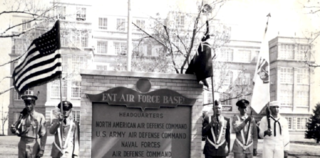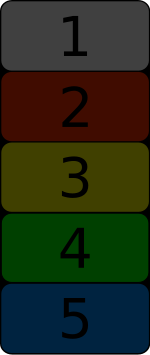
Strategic Air Command (SAC) was a United States Department of Defense Specified Command and a United States Air Force (USAF) Major Command responsible for command and control of the strategic bomber and intercontinental ballistic missile components of the United States military's strategic nuclear forces from 1946 to 1992. SAC was also responsible for strategic reconnaissance aircraft; airborne command posts; and most of the USAF's aerial refueling aircraft.

North American Aerospace Defense Command, known until March 1981 as the North American Air Defense Command, is a combined organization of the United States and Canada that provides aerospace warning, air sovereignty, and protection for Canada and the continental United States.
EMERGCON is a state of readiness that is separate from DEFCON, or defense readiness condition used by the United States, in that it incorporates civilian measures in addition to the DEFCON military measures.

The United States Indo-Pacific Command (USINDOPACOM) is the unified combatant command of the United States Armed Forces responsible for the Indo-Pacific region.

The Single Integrated Operational Plan (SIOP) was the United States' general plan for nuclear war from 1961 to 2003. The SIOP gave the President of the United States a range of targeting options, and described launch procedures and target sets against which nuclear weapons would be launched. The plan integrated the capabilities of the nuclear triad of strategic bombers, land-based intercontinental ballistic missiles (ICBM), and sea-based submarine-launched ballistic missiles (SLBM). The SIOP was a highly classified document, and was one of the most secret and sensitive issues in U.S. national security policy.

The United States Strategic Command (USSTRATCOM) is one of the eleven unified combatant commands in the United States Department of Defense. Headquartered at Offutt Air Force Base, Nebraska, USSTRATCOM is responsible for strategic nuclear deterrence, global strike, and operating the Defense Department's Global Information Grid. It also provides a host of capabilities to support the other combatant commands, including integrated missile defense; and global command, control, communications, computers, intelligence, surveillance, and reconnaissance (C4ISR). This command exists to give "national leadership a unified resource for greater understanding of specific threats around the world and the means to respond to those threats rapidly".

The National Military Command Center (NMCC) is a Pentagon command and communications center for the National Command Authority. Maintained by the Department of the Air Force as the "DoD Executive Agent" for NMCC logistical, budgetary, facility, and systems support; the NMCC operators are in the Joint Staff's J-3 (Operations) Directorate. "The NMCC is responsible for generating Emergency Action Messages (EAMs) to missile launch control centers, nuclear submarines, recon aircraft, and battlefield commanders".

The Raven Rock Mountain Complex (RRMC), also known as Site R, is a U.S. military installation with an underground nuclear bunker near Blue Ridge Summit, Pennsylvania, at Raven Rock Mountain that has been called an "underground Pentagon". The bunker has emergency operations centers for the United States Army, Navy, Air Force and Marine Corps. Along with Mount Weather Emergency Operations Center in Virginia and the Cheyenne Mountain Complex in Colorado, it formed the core bunker complexes for the US continuity of government plan during the Cold War to survive a nuclear attack.

General Thomas Sarsfield Power was a United States Air Force officer who served as commander in chief of the Strategic Air Command from 1957-1964. He was an active military flier for more than 30 years.
The AN/FRC-117 Survivable Low Frequency Communications System (SLFCS) was a communications system designed to be able to operate, albeit at low data transfer rates, during and after a nuclear attack. The system used both very low frequency (VLF), and low frequency (LF) radio bands.

Operation Chrome Dome was a United States Air Force Cold War-era mission from 1961 to 1968 in which B-52 strategic bomber aircraft armed with thermonuclear weapons remained on continuous airborne alert, flying routes that put them in positions to attack targets in the Soviet Union if they were ordered to do so. The exact routes varied by year, but in general there were routes that went to positions over the Canadian arctic, Alaska, Greenland, and the Mediterranean Sea. Many American Air Force Bases in the 1960s allocated at least one bomber crew to "Chrome Dome" duty on a regular basis, and many other bases, including foreign bases, were involved in the refueling operations. Over the years the mission involved overflights of American, Canadian, Danish (Greenland), and Spanish territory, among others. The goal of "Chrome Dome" was to keep a number of nuclear-armed aircraft in a position to help guaranteed nuclear retaliation against the Soviet Union in the event that the latter was somehow able to destroy the majority of US nuclear weapons still on the ground, while also ensuring that Strategic Air Command bomber crews had experience with airborne alert procedures so that, in the event of heightened concern, the number of patrolling bombers could be increased dramatically. Several high-profile nuclear accidents were associated with the "Chrome Dome" program, including the accidental release of nuclear weapons on foreign territory, and it was shut down in the wake of one such accident in 1968.

The Emergency Rocket Communications System (ERCS) was designed to provide a reliable and survivable emergency communications method for the United States National Command Authority, using a UHF repeater placed atop a Blue Scout rocket or Minuteman II intercontinental ballistic missile. ERCS was deactivated as a communication means when President George H.W. Bush issued a message to stand down SIOP-committed bombers and Minuteman IIs on 27 September 1991. Headquarters SAC was given approval by the Joint Chiefs of Staff to deactivate the 494L payloads beginning 1 October 1992. However, Headquarters SAC believed it was inefficient and unnecessary to support ERCS past fiscal year 1991, and kept the accelerated deactivation schedule.

The Chidlaw Building is a former United States Air Force facility located in the Knob Hill neighborhood of Colorado Springs, Colorado. The building was close to, but not within, the Ent Air Force Base complex, and was leased by the military for several decades, housing headquarters for several military commands, starting with the Air Defense Command (ADC) and the North American Aerospace Defense Command (NORAD). When Chidlaw was completed, personnel from multiple locations, including the Ent Air Force Base, were consolidated into the new building.
In the armed forces, most often in military aviation and in land-based missile forces, an alert crew is a group of members of units and formations that maintains a group level of combat readiness. Although it sometimes encompasses the entire unit, today the term is more used for a set group of individuals.

The ITT 465L Strategic Air Command Control System was a Cold War "Big L" network of computer and communication systems for command and control of Strategic Air Command "combat aircraft, refueling tankers, [and] ballistic missiles". International Telephone and Telegraph was the prime contractor for Project 465, and SACCS had "Cross Tell Links" between command posts at Offutt AFB, March AFB, & Barksdale AFB (SACCS also communicated with the Cheyenne Mountain Complex and Air Force command posts. The 465L System included IBM AN/FSQ-31 SAC Data Processing Systems, Remote and Simplex Remote Communication Systems, SAC Network Control Office, "4-wire, Schedule 4, Type 4B alternate voice-data operation", and one-way communication with "ICBM launch control centers" In addition to IBM for the "Super SAGE type computers", another of the 6 direct subcontractors was AT&T,
The National Military Command System (NMCS) was the federal government of the United States' Cold War command and control system that consisted of the National Military Command Center (NMCC) at The Pentagon, the Alternate National Military Command Center (NMCC) at Pennsylvania Raven Rock Mountain, 3 National Emergency Airborne Command Post (NEACP) aircraft on 24-hour ground alert, 2 National Emergency Command Post Afloat (NECPA) ships, "and interconnecting communications".

Continental Air Defense Command (CONAD) was a Unified Combatant Command of the United States Department of Defense, tasked with air defense for the Continental United States. It comprised Army, Air Force, and Navy components. It included Army Project Nike missiles anti-aircraft defenses and USAF interceptors. The primary purpose of continental air defense during the CONAD period was to provide sufficient attack warning of a Soviet bomber air raid to ensure Strategic Air Command could launch a counterattack without being destroyed. CONAD controlled nuclear air defense weapons such as the 10 kiloton W-40 nuclear warhead on the CIM-10B BOMARC. The command was disestablished in 1975, and Aerospace Defense Command became the major U.S. component of North American Air Defense Command (NORAD).

The Missile Warning Center (MWC) is a center that provides missile warning and defense for United States Space Command's Combined Force Space Component Command, incorporating both space-based and terrestrial sensors. The MWC is located at Cheyenne Mountain Space Force Station.

A nuclear close call is an incident that might have led to at least one unintended nuclear detonation or explosion, but did not. These incidents typically involve a perceived imminent threat to a nuclear-armed country which could lead to retaliatory strikes against the perceived aggressor. The damage caused by international nuclear exchange is not necessarily limited to the participating countries, as the hypothesized rapid climate change associated with even small-scale regional nuclear war could threaten food production worldwide—a scenario known as nuclear famine. There have also been a number of accidents involving nuclear weapons, such as crashes of nuclear armed aircraft.
The Joint Chiefs of Staff (JCS) Readiness Test was a secret test and alert of U.S. military forces staged by the U.S. Department of Defense. It began on October 12, 1969, and consisted of a variety of military moves around the world, including activities by U.S. air and naval forces from the continental U.S. to the North Atlantic and from the Middle East to the Western Pacific.















